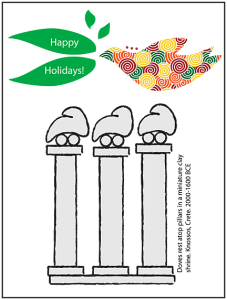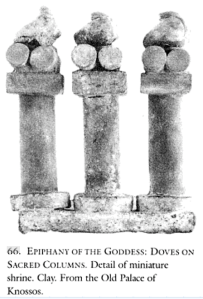
Title: Hexbreaker (Hexworld #1)
...-
 WICCA CRAFT - TAO CRAFT - ADOMI CRAFT, ETC. - it's a world on its own from ancient history. What then seems to be a problem toda
WICCA CRAFT - TAO CRAFT - ADOMI CRAFT, ETC. - it's a world on its own from ancient history. What then seems to be a problem toda
 PaganSquare.com - WitchesAndPagans.com
PaganSquare.com - WitchesAndPagans.com PaganSquare is a community blog space where Pagans can discuss topics relevant to the life and spiritual practice of all Pagans.

Title: Hexbreaker (Hexworld #1)
...
Glastonbury, an ancient Goddess site. I've longed forever to be here and now that I am the visions are flowing and I am constantly feeling higher vibrational. In my visionary state I see that Glastonbury was once surrounded by rings of water, an ancient Atlantean form! Where this form is, people are very happy, peaceful and creative. It is like a womb, an emergence point for much celestial stellar energy.
Walking on fecund sacred ground here once again, I experienced a deep profound sense of peace in my heart and groundedness like I hadn’t felt in a long while. I was home.
... It's been three — and thirty — years in the making.
It's been three — and thirty — years in the making.
Now the dream's coming true: The Woman's Belly Book has just been published in its French edition by Le Courrier du Livre.
I'm going to France this summer to share the good news — we hold the power to promote creation within our body's center, within our bellies.
The book's French title means "become friends with your belly" or more simply, "befriend your belly." The subtitle refers to the practice of belly-energizing movement and breath: "5 minutes a day to connect with your source of energy."
If you've read The Woman's Belly Book, you know how the Source Energy concentrated within our body's center connects with the Sacred Feminine as she dwells within us. And with the presence of Mary Magdalene as she brings the Sacred Feminine into life and into form.
In addition to leading a workshop at Centre Tao in Paris, I'll be visiting bookstores and libraries to present readings. What's more, I'll be visiting sites that share the energy of Mary Magdalene.
And so the adventure continues!
As the new edition has emerged, I've delighted in learning how English expressions translate into French. For example, the English words for "trust your gut" become "avoir du cœur au ventre" in French. That's literally "have heart in your belly." Trust your gut, love your belly.
In upcoming posts I'll say more about the "belly magic" threading through my dream, my intention, of sharing this work with women worldwide. I'll give you the introduction I wrote (in English) for this new French edition. And I'll post notes of my journey through France this summer.
For now, if you or your friends read French, or are French, here's something for you: Anne Delmas, the splendid woman who translated The Woman's Belly Book, provides a fine description of the book's French incarnation here.
 Every year, it seems, I'm bewildered by all the fuss about Christmas. And every year I eventually rediscover, or revive, a meaning for the season.
Every year, it seems, I'm bewildered by all the fuss about Christmas. And every year I eventually rediscover, or revive, a meaning for the season.
This year, as in other years, it's happened a day or two before December 25, and now I'm scrambling to join the Christmas cheer. This is the story...
I'd recently finished reading Margaret Starbird's Magdalene's Lost Legacy: Symbolic Numbers and the Sacred Union in Christianity. Another of her books about Mary Magdalene, The Woman with the Alabaster Jar: Mary Magdalen and the Holy Grail, was a major inspiration when I was writing The Woman's Belly Book, so intrigue led me to read more of her work.
In Magdalene's Lost Legacy, Starbird presents the system of number-coding called gematria, how it figured in the writings of early Christians, and what it means for understanding Mary Magdalene and the return of the Sacred Feminine to Western culture.
These subjects are, of course, intricate and deep. Here's how I've rolled them into this year's Christmas card — and how they've spiralled into the Source Energy, the pro-creative power, dwelling within our body's center:
•
What's gematria? The way I'm understanding it, gematria is an ancient practice that links mind to spirit by relating letters to the vast significance of number.
Greek and Hebrew alphabets imbue each letter with a numerical value. Summing the numbers assigned to each of the letters in a word reveals another number, another dimension of meaning, another connection to human experience. The Greek word for “dove” is peristera, written περιστερα, with these numerical values:

These Greek letters spelling “dove” add to 801. The number 800 corresponds to the Greek omega (Ω); the number one corresponds to alpha (α). With gematria of 801, the dove is the “Alpha and Omega,” the unity of beginning and end. Reaching from first to last, it is completion, fulfillment.
What's more, the sum of the numerals comprising 801 is 9, a trinity of threes, the epitome of three. Three carries the significance of the circle, the unconditional acceptance that encompasses both this and that. Three enfolds dualities into one wholeness: the Sacred Marriage yields the Divine Child.
For the early Greeks, the dove signalled the presence of Aphrodite, embodiment of love and beauty — she who brings life, death, and peace to the world. Early Christians understood the dove to signify Sophia, Holy Wisdom; they later adopted the dove as sign of the Holy Spirit.
The gematria of “Holy Spirit” (το αγιον πνευμα) is 1080. That same number, its numerals adding to nine, is the measure of the moon‘s radius in miles. Given numbers one, eight, and nine, gematria links Holy Spirit with moon, goddess, Sophia, the feminine — and with the dove.
In this light, the dove (801) coming to rest upon Jesus’ shoulder at his baptism in the River Jordan heralds the descent of the Holy Spirit (1080) — Sophia — into his nature. Indeed, early Gnostic Christians understood Sophia to be incarnate in the dove sparking Mary’s pro-creative power to birth Jesus as the child of Holy Wisdom.
•
Pro-creative power, yes.
That's what more or less fits into a Christmas greeting. For the illustration, I filled the dove with a pattern of Chinese spirals and sent her flying over a shrine in which doves perch atop three pillars. This miniature clay shrine, found in Knossos, Crete, dates to 2000 years before the birth of Jesus.
What about those pillars?
As the Rite for Reconsecrating Our Womanhood was developing, I called number 13 in this sequence of belly-energizing exercises "Stretch Up/Press Down," describing its way of tracing a vertical axis.
As I did with each of the 23 moves in the sequence, I paired this gesture with an ancient artifact conveying a sense of the Sacred Feminine. In this case, I paired the move with an image of pillar, recalling Sophia's "pillars of wisdom":
Wisdom has built her house,
She has hewn out her seven pillars...
— Proverbs 9:1
I made a clay replica of the three-pillar shrine presented in Elinor Gadon's The Once and Future Goddess. (For more detail, see the color photograph of the original, displayed at Greece's Heraklion Archaeological Museum, here.) I also sketched the shrine as a line drawing.


Incorporating that sketch, the Rite for Reconsecrating Our Womanhood shows Stretch Up/Press Down as a gesture of affirmation: As we let go of preconceptions and expectations, we can attune more nearly to our inner wisdom, to Sophia:
Still, pillars are powerful phallic emblems, and doves perched upon pillars show us something about the Sacred Marriage.
Indeed, there's a lot of Sacred Marriage going on this season:
The shaft of light at the dawn of winter solstice penetrating deep into the dark of Neolithic earthworks such as the tomb at Newgrange, County Meath, Ireland. The Hebrew Shekinha — the word's Semitic root refers to birds nesting — partnering Yahweh. The virgin Mary partnering Deus. The prelude to Mary Magdalene, understood by early Gnostic Christians as an incarnation of Sophia, partnering Jesus.
Maybe next year I'll be writing a post titled "Sex and the Santa Claus."
 Recently I saw Spotlight, the movie. Set in 2001-2002, the film chronicles how the Boston Globe's team of investigative reporters revealed the pattern of child sexual abuse rampant among Massachusetts' Catholic priests — and the Boston Archdiocese's systematic cover-up.
Recently I saw Spotlight, the movie. Set in 2001-2002, the film chronicles how the Boston Globe's team of investigative reporters revealed the pattern of child sexual abuse rampant among Massachusetts' Catholic priests — and the Boston Archdiocese's systematic cover-up.
Early on, the film gives us psychotherapist Richard Sipe. He's been braving the Church's opposition and documenting this pattern for decades. He cites one aspect of the problem's origin: the secretive atmosphere surrounding priests' sexual activity.
Sipe estimates that, at any point in time, about half of all priests are engaged in a sexual relationship, despite their vow of celibacy. Given the film's timeframe, Sipe's "metric" indicates that 6% of all priests are molesting children. With further research, Sipe later revised that figure to 9%.
Recently I also read Margaret Starbird's book, Mary Magdalene: Bride in Exile (Bear & Company, Rochester, Vermont, 2005). Another of her books on Mary Magdalene, The Woman with the Alabaster Jar, was a central, inspiring resource for me back when I was writing The Woman's Belly Book.
Starbird presents a convincing argument that Jesus, being Jewish and according to Jewish custom, would most likely have been a married man. His partnership with Mary Magdalene as wife, consort, and colleague would have testified to the wholeness, and sanity, of creation.
Starbird links the Church's 12th-century rule of priestly celibacy with its denial both of Mary Magdalene's relationship with Jesus and of the Sacred Feminine:
In the aftermath of scandals involving Roman Catholic priests, people are now, for the first time in centuries, seriously asking, "What else did they forget to tell us?" Because the current crisis of confidence in the Catholic hierarchy is directly related to this hierarchy's dissociation from the sacred feminine, the relationship of Jesus and Mary Magdalene is entirely relevant to the problem. Enforced clerical celibacy, after centuries of devaluing the feminine half of creation, was mandated in 1139 when an edict by Pope Innocent II forced married priests to abandon their wives and children. (p. 150)
Absent Magdalene, insanity arises in a multitude of forms.
Spotlight shines the light on one form of insanity: Nearly one in ten Catholic priests have engaged in sexually abusing children.

"How would you like to be interviewed for a book that questions the historical existence of Jesus?" asked Minas, a journalist, editor, and old-time friend of mine. "I'd love it if you would like to point out the similarities between Jesus and Dionysus." It was an offer I couldn't resist. The interview turned out to me more than 5000 words long, opening a host of fascinating topics. It is included in the book Jesus Mythicism: An Introduction, whose English translation recently came out. It is written by Minas Papageorgiou and also includes interviews by well-known scholars, such as Maria Dzielska, Payam Nabarz, and Joseph Atwill.
I'm delighted to share a part of my interview with you, with permission from the book's author.
...